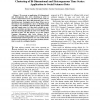5 search results - page 1 / 1 » K-means clustering of proportional data using L1 distance |
ICPR
2008
IEEE
14 years 6 months ago
2008
IEEE
We present a new L1-distance-based k-means clustering algorithm to address the challenge of clustering high-dimensional proportional vectors. The new algorithm explicitly incorpor...
ISAAC
2009
Springer
13 years 11 months ago
2009
Springer
The k-means algorithm is the method of choice for clustering large-scale data sets and it performs exceedingly well in practice. Most of the theoretical work is restricted to the c...
DMIN
2006
13 years 6 months ago
2006
We present an application of bi-dimensional and heterogeneous time series clustering in order to resolve a Social Sciences issue. The dataset is the result of a survey involving mo...
IDEAL
2004
Springer
13 years 10 months ago
2004
Springer
Microarray datasets are often too large to visualise due to the high dimensionality. The self-organising map has been found useful to analyse massive complex datasets. It can be us...
NN
2002
Springer
13 years 4 months ago
2002
Springer
The self-organising map (SOM) has been successfully employed as a nonparametric method for dimensionality reduction and data visualisation. However, for visualisation the SOM requ...

